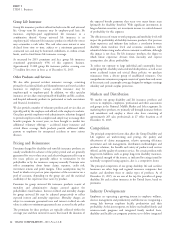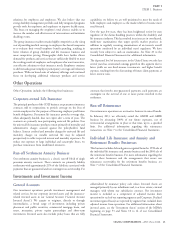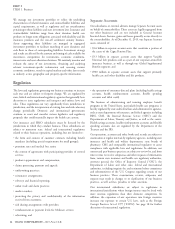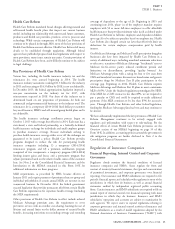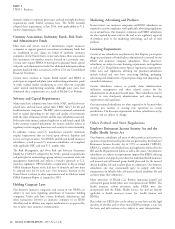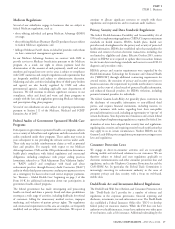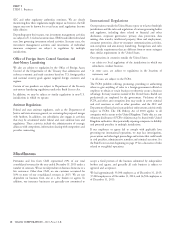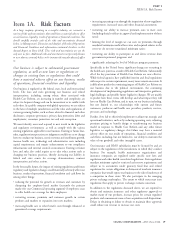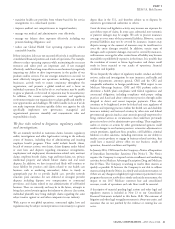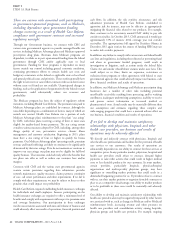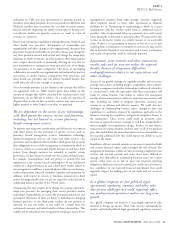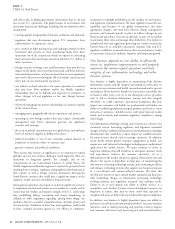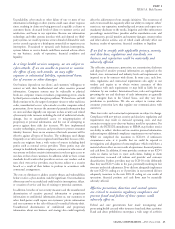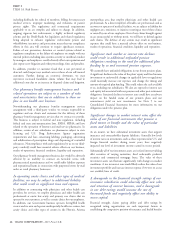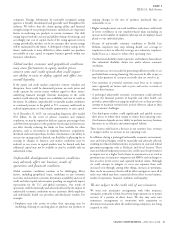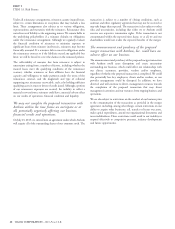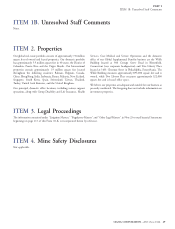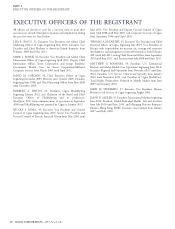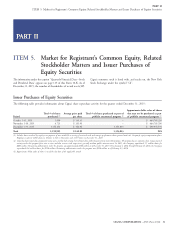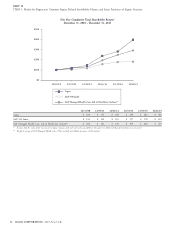Cigna 2015 Annual Report Download - page 52
Download and view the complete annual report
Please find page 52 of the 2015 Cigna annual report below. You can navigate through the pages in the report by either clicking on the pages listed below, or by using the keyword search tool below to find specific information within the annual report.PART I
ITEM 1A. Risk Factors
cash flows. In addition, the risk corridor, reinsurance, and risk
There are various risks associated with participating
adjustment provisions of Health Care Reform, established to
in government-sponsored programs, such as Medicare,
apportion risk for insurers, may not be effective in appropriately
including dependence upon government funding,
mitigating the financial risks related to our products. For example,
changes occurring as a result of Health Care Reform,
there continues to be uncertainty around CMS’ ability to pay risk
compliance with government contracts and increased
corridor receivables. In October 2015, CMS announced it would pay
regulatory oversight.
approximately 13% of insurers’ 2014 coverage year risk corridor
receivables. The appropriations bill signed by President Obama in
Through our Government business, we contract with CMS and December 2015 again restricts the sources of funding HHS may use
various state governmental agencies to provide managed health care to make risk corridor payments.
services including Medicare Advantage plans and Medicare-approved
prescription drug plans. Revenues from Medicare programs are In addition, any failure to comply with various state and federal health
dependent, in whole or in part, upon annual funding from the federal care laws and regulations, including those directed at preventing fraud
government through CMS and/or applicable state or local and abuse in government funded programs, could result in
governments. Funding for these programs is dependent on many investigations or litigation, such as actions under the federal False
factors outside our control including general economic conditions, Claims Act and similar whistleblower statutes under state laws. This
continuing government efforts to contain health care costs and could subject us to fines, limits on expansion, restrictions or
budgetary constraints at the federal or applicable state or local level exclusions from programs or other agreements with federal or state
and general political issues and priorities. These entities generally have governmental agencies that could adversely impact our business, cash
the right to not renew or cancel their contracts with us on short notice flows, financial condition and results of operations.
without cause or if funds are not available. Unanticipated changes in In addition, our Medicare Advantage and Medicare prescription drug
funding, such as the application of sequestration by the federal or state businesses face a number of other risks including potential
governments, could substantially reduce our revenues and uncollectible receivables resulting from processing and/or verifying
profitability. enrollment, inadequate underwriting assumptions, inability to receive
The Medicare program has been the subject of regulatory reform and process correct information or increased medical or
initiatives, including Health Care Reform. The premium rates paid to pharmaceutical costs. Actual results may be materially different than
Medicare Advantage plans are established by contract, although the our assumptions and estimates regarding these complex and
rates differ depending on a combination of factors, many of which are wide-ranging programs that could have a material adverse effect on
outside our control. Health Care Reform ties a portion of each our business, financial condition and results of operations.
Medicare Advantage plan’s reimbursement to the plan’s ‘‘star rating’’
by CMS, with those plans receiving a rating of three or more stars
If we fail to develop and maintain satisfactory
eligible for quality-based bonus payments. The star rating system
relationships with physicians, hospitals and other
considers various measures adopted by CMS, including, among other
health care providers, our business and results of
things, quality of care, preventative services, chronic illness
operations may be adversely affected.
management and customer satisfaction. Beginning in 2015, plans
must have a star rating of four or higher to qualify for bonus We directly and indirectly contract with physicians, hospitals and
payments. Our Medicare Advantage plans’ operating results, premium other health care professionals and facilities for the provision of health
revenue and benefit offerings are likely to continue to be significantly care services to our customers. Our results of operations are
determined by their star ratings. If we do not maintain or continue to substantially dependent on our ability to contract for these services at
improve our star ratings, our plans may not be eligible for full-level competitive prices. In any particular market, physicians, hospitals and
quality bonuses. That outcome could adversely affect the benefits that health care providers could refuse to contract, demand higher
our plans can offer as well as reduce our customer base and/or payments or take other actions that could result in higher medical
margins. costs or less desirable products for our customers. In some markets,
certain providers, particularly hospitals, physician/hospital
Contracts with CMS and the various state governmental agencies organizations and multi-specialty physician groups, may have
contain certain provisions regarding data submission, provider significant or controlling market positions that could result in a
network maintenance, quality measures, claims payment, continuity diminished bargaining position for us. If providers refuse to contract
of care, call center performance and other requirements. If we fail to with us, use their market position to negotiate favorable contracts or
comply with these requirements, we may be subject to fines or other place us at a competitive disadvantage, our ability to market products
penalties that could impact our profitability. or to be profitable in those areas could be materially and adversely
Health Care Reform required establishing health insurance exchanges affected.
for individuals and small employers. Insurers participating on the Our ability to develop and maintain satisfactory relationships with
health insurance exchanges are required to offer a minimum level of health care providers also may be negatively impacted by other factors
benefits and comply with requirements with respect to premium rates not associated with us, such as changes in Medicare and/or Medicaid
and coverage limitations. Our participation in these exchanges reimbursement levels, increasing revenue and other pressures on
involves uncertainties associated with mix and volume of business and health care providers and consolidation activity among hospitals,
could adversely affect our results of operations, financial position and physician groups and health care providers. For example, ongoing
22 CIGNA CORPORATION - 2015 Form 10-K


